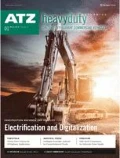If certain media reports are anything to go by, the end of the road is in sight for combustion engines. It cannot be denied that the ongoing debate about nitrogen oxide pollution in German cities puts more pressure on manufacturers to curb emissions. This is also true of the looming EU regulations expected to reduce CO2 emissions produced by heavy-duty commercial vehicles. I suggest we look on the bright side: our industry has the chance to do something to improve people’s quality of life. I am adamant in saying that it is our duty to offer solutions that are as sustainable as possible for every application. Those solutions have to stand out thanks to their efficiency and reliability. What people often forget, however, is that our industry is already offering alternatives to diesel engines that produce lower emissions.
In actual fact, the introduction of the Euro VI emission standard for diesel trucks has cut emissions drastically. Alternative fuels such as biodiesel, e-fuels, and LNG make further reductions possible. LNG, which has been a popular fuel in Italy for decades, offers particular benefits: up to 15 % less CO2 compared to diesel and virtually no particulate or NOx emissions. A number of commercial vehicle manufacturers, including Scania and its cooperation partnership with Volkswagen Group Logistics, are working on LNG solutions for long-haul transportation. CNG, on the other hand, has been a well-established alternative for city buses for a number of years. With a market share of around 40 %, MAN is leading the way for this segment in Europe. The second argument in favor of combustion engines is how well they lend themselves to use in long-haul distribution, construction vehicles, and on difficult terrain. While a range of at least one thousand kilometers is essential for long-haul distribution, when it comes to off-roading the high energy requirements of electric drives installed in off-road vehicles are stretched to the limits of their range quickly. In light of this, combustion engines have a significant role to play as a technology to bridge the gap.
While it is likely to take some time for electric heavy-duty commercial vehicles to be operated on a large scale in Europe, electric drives remain the ideal choice for a number of applications, including city buses with clearly defined routes and standing times as well as vans for last-mile transportation and medium- to heavy-duty distribution trucks that cover less than 200 km a day. With this in mind, I am certain that electric drives have a future for the applications I have mentioned — thanks to technological progress and the increase in the number of units produced. I expect to see different types of drives working together in the future, thus helping to lower emissions and improve the quality of urban living. Current developments present an extraordinary challenge to manufacturers of course. They have to continue improving diesel drives while optimizing combustion engines with alternative fuels and helping electric drives achieve market maturity at the same time.
Author information
Authors and Affiliations
About this article
Cite this article
Nielsen, A. The Future of the Combustion Engine. ATZ offhighw worldw 11, 58 (2018). https://doi.org/10.1007/s41321-018-0029-8
Published:
Issue Date:
DOI: https://doi.org/10.1007/s41321-018-0029-8

